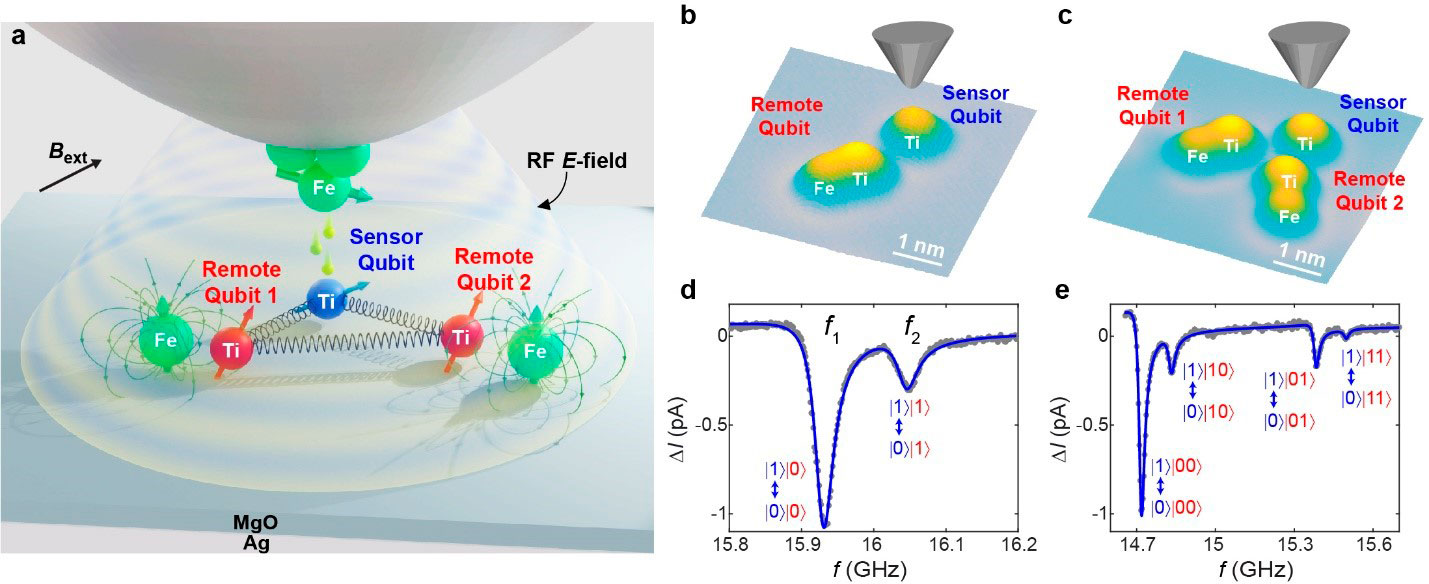A new qubit platform, created atom by atom
An international research team has presented 1 a new quantum platform based on the electron spin of single atoms on a solid surface, achieving a ‘multiple qubit (quantum bit)’ system using three electron spins. Unlike previous atomic quantum devices on surfaces where only a single qubit could be controlled, the researchers have successfully demonstrated the ability to control multiple qubits simultaneously, enabling the application of single-, two-, and three-qubit gates.

The fundamental unit for information storage and computation in computers is the bit, which can have a value of either 0 or 1. In contrast, quantum computers operate with qubits as their fundamental unit, which can perform computations in a superposition of 0 and 1 states, meaning that they can exist simultaneously in both states, like the paradox of the Schrödinger’s cat. This capacity results in significantly enhancing the performance in terms of information storage and processing speed compared to classical computers.
To commercialize quantum computers, various types of qubits have been proposed using superconducting junctions, ion traps, quantum dots, and quantum phase states. However, due to the relatively short history of quantum information science, the challenge to design an optimal qubit system is still on. For decades, scientists have aspired to construct a quantum-coherent architecture at the atomic scale, a realm where the fundamental properties of atoms, like electron spin, holds its way. Such an achievement could revolutionize quantum science and nanotechnology. Yet, building an atomic-scale quantum architecture, capable of precise assembly, controlled coupling, and coherent operation of multiple electron-spin qubits, has remained an extraordinary challenge.
In fact, there is a need for fundamental scientific research to implement a new quantum platform that addresses the shortcomings of existing qubits while increasing their integration and reliability.
Using scanning tunneling microscopy (STM) have proven very useful to measure and control the electronic states of individual atoms, exploiting quantum mechanical phenomena. In this work, combining STM and ESR (electron spin resonance) technology, projecting microwave pulses onto individual titanium atoms on the surface lead to successfully controlling and measuring the spin states. As a result, precise control of the spin of a single atom and setting it to the desired quantum state became possible. The remaining challenge was to implement a multi-qubit system capable of controlling several qubits simultaneously. The qubit platform presented in this work consists of multiple titanium atoms placed on the surface of a thin insulator (magnesium oxide) and has succeeded in the challenge.
The researchers used the probing of a scanning tunneling microscope (STM) precisely manipulating the positions of each atom, creating a structure of multiple titanium atoms where their spins can interact [see Figure 2]. Subsequently, they applied a remote control method to the titanium atom that serve as sensor (sensor qubit) and successfully controlled and measured multiple qubits (remote qubits) placed at a distance with a single probe.
Since each remote qubit interacts with the sensor qubit, changes in the spin state of the remote qubits affect the sensor qubit, and this change is read through the probe. The researchers also implemented the fundamental operations of quantum information processing, ‘CNOT’ (Controlled NOT gate) and ‘Toffoli’ gates, using this qubit platform. The research was conducted at a temperature of 0.4K (-272.6°C).
“Manipulating multiple qubits remotely at the atomic level is truly remarkable,” said one of the researchers. “Until now, we could only control a single qubit on the surface, but through this research, we have made a significant leap in implementing multiple qubit systems at the atomic level.”
The platform introduced in this study has the advantage of precise control of information exchange between qubits at the atomic level. It is also distinctive from existing qubit platforms because it can implement quantum integrated circuits with individual qubits smaller than 1nm. Additionally, unlike other platforms that require specific materials (superconducting junction qubits), it allows for the selection of various atoms as qubit materials beyond Titanium.
As for the future implementation and application of these results, applying the implemented qubit system for practical quantum information processing, will require to secure a sufficiently long operation time to perform various quantum operations continuously while increasing the number of qubits. Using the method introduced in this research, it is expected that up to 5-6 qubits could be connected and operated, but further research is needed to develop a platform that could control more than 10 qubits simultaneously by improving the connections and measurement methods between qubits.
Text supplied by UPV/EHU, edited by César Tomé López
References
- Yu Wang, Yi Chen, Hong T. Bui, Christoph Wolf, Masahiro Haze, Cristina Mier, Jinkyung Kim, Deung-Jang Choi, Christopher P. Lutz, Yujeong Bae, Soo-hyon Phark, and Andreas J. Heinrich (2023) An atomic-scale multi-qubit platform Science doi: 10.1126/science.ade5050 ↩